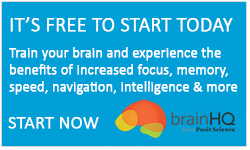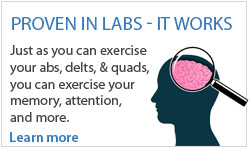The following Q&A was prepared by Posit Science.
Q: What is the news?
A: For the first time, independent academic researchers have evaluated commercially available brain training programs to determine each program’s scientific evidence base. Out of 18 programs evaluated, 11 had no data at all, and only two met the study’s highest criteria for evidence having been evaluated in two published trials, one with high quality and second with at least of moderate quality. BrainHQ from Posit Science met the highest criteria, and outpaced all others with 10 studies, of which 8 were of the highest quality.
Q: How was the evaluation conducted?
A: The researchers first scoured the web to identify commercially available brain training programs, and identified 32. Of these, they evaluated the 18 that were directed at healthy older adults. Next, the researchers conducted a broad search of the scientific literature, looking for papers involving brain training (or similar terms). This yielded 8,268 scientific publications. Of these, the researchers identified 244 that were directly relevant based on their title and abstract, and fully read each. Two hundred and eighteen were put aside because they involved study populations that were not healthy older adults, or did not have measures of cognitive function. This led to 26 studies for full evaluation. Each study was classified with a standard measure (the PEDro score) for the quality of its design and execution, and evaluated for funding source (independently funded vs. company funded).
Q: What brain training programs were evaluated?
A: The 7 programs with at least one study were BrainHQ (from Posit Science), Cognifit, CogMed, Brain Age, My Brain Trainer, Dakim, and Lumosity. The 11 programs with no evidence were not specified in the review report.
Q: Who were the scientists who organized the review?
A: The authors were Tejal Shah, Michael Weinborn, Giuseppe Verdile, Hamid Sohrabi, & Ralph Martins. All are affiliated with the Centre of Excellence for Alzheimer’s Disease Research & Care, School of Medical Sciences, Edith Cowan University, in Australia, and across the group, they hold appointments at another four institutes, making this a report from researchers connected to five institutes
Q: Why is this group of scientists authoritative?
A: The authors have direct experience running clinical trials of brain training programs before, having authored “A combination of physical activity and computerized brain training improves verbal memory and increases cerebral glucose metabolism in the elderly” in 2014. Senior author Dr. Ralph Martins is a world authority on Alzheimer’s disease he was the first scientist to isolate and characterize betaamyloid and its precursor, the amyloid precursor protein (APP), which are now recognized as central to the pathogenesis of Alzheimer's disease.
Q: How does this review fit in with previous reviews?
A: Multiple systematic reviews and metaanalyses have now examined the scientific literature around brain training, with virtually all concluding that the literature supports the viewpoint that brain training can improve cognitive function. However, previous reviews have generally grouped all forms of brain training together, which grouped programs with proven efficacy and positive study results together with programs without proven efficacy or negative results. The current study extends these previous results by sorting the studies by brain training program manufacturer, and showing that some programs have much more evidence than others, and some programs have no evidence at all.
Q: I’ve heard that brain training programs haven’t been shown to work how is that consistent with this study?
A: Most brain training programs haven’t been shown to work. Eleven of the programs evaluated in this study had no published evidence, and 5 more had only one study, typically of moderate or lower quality. However, the leader of the pack BrainHQ from Posit Science had 8 high quality trials backing it up. Of course many more papers have actually been published using Posit Science exercises each study typically results in several papers. When measured by published papers, at last count there were 56 papers published about Posit Science brain training exercises from studies in healthy aging (and more than 120 including clinical conditions, such as brain injury).
Q: What are the implications of this study?
A: Doctors, scientists, policy makers, health care plans, and anyone looking to know what brain training programs have been shown to work can use this review to summarize what leaders in the field of aging and Alzheimer’s research currently think that not all brain training programs are the same, that people should make decisions about their brain health based on scientific evidence, and that BrainHQ from Posit Science is the leader in evidencebased brain training.






 English
English
 Français
Français


